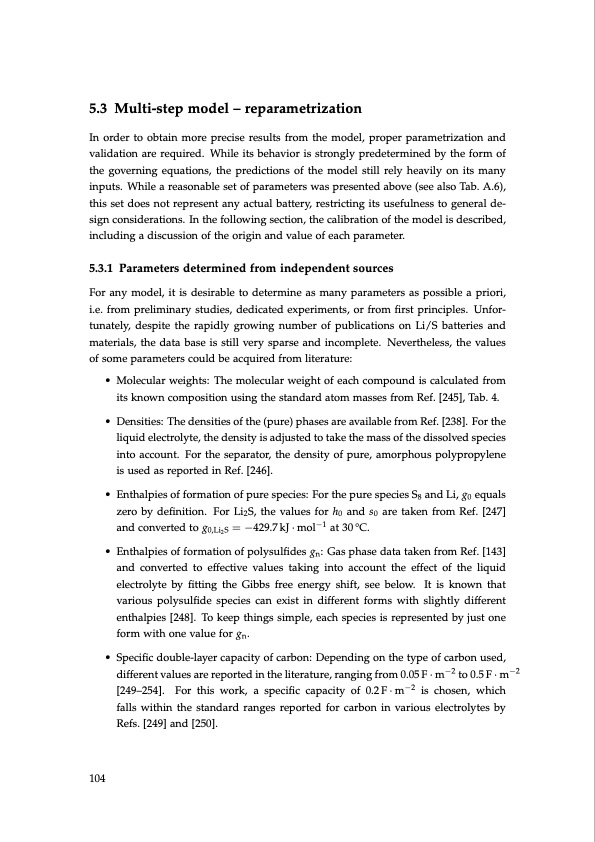
PDF Publication Title:
Text from PDF Page: 104
5.3 Multi-step model – reparametrization In order to obtain more precise results from the model, proper parametrization and validation are required. While its behavior is strongly predetermined by the form of the governing equations, the predictions of the model still rely heavily on its many inputs. While a reasonable set of parameters was presented above (see also Tab. A.6), this set does not represent any actual battery, restricting its usefulness to general de- sign considerations. In the following section, the calibration of the model is described, including a discussion of the origin and value of each parameter. 5.3.1 Parameters determined from independent sources For any model, it is desirable to determine as many parameters as possible a priori, i.e. from preliminary studies, dedicated experiments, or from first principles. Unfor- tunately, despite the rapidly growing number of publications on Li/S batteries and materials, the data base is still very sparse and incomplete. Nevertheless, the values of some parameters could be acquired from literature: • Molecular weights: The molecular weight of each compound is calculated from its known composition using the standard atom masses from Ref. [245], Tab. 4. • Densities: The densities of the (pure) phases are available from Ref. [238]. For the liquid electrolyte, the density is adjusted to take the mass of the dissolved species into account. For the separator, the density of pure, amorphous polypropylene is used as reported in Ref. [246]. • Enthalpies of formation of pure species: For the pure species S8 and Li, g0 equals zero by definition. For Li2S, the values for h0 and s0 are taken from Ref. [247] and converted to g0,Li2 S = −429.7 kJ · mol−1 at 30 °C. • Enthalpies of formation of polysulfides gn: Gas phase data taken from Ref. [143] and converted to effective values taking into account the effect of the liquid electrolyte by fitting the Gibbs free energy shift, see below. It is known that various polysulfide species can exist in different forms with slightly different enthalpies [248]. To keep things simple, each species is represented by just one form with one value for gn. • Specific double-layer capacity of carbon: Depending on the type of carbon used, different values are reported in the literature, ranging from 0.05 F · m−2 to 0.5 F · m−2 [249–254]. For this work, a specific capacity of 0.2 F · m−2 is chosen, which falls within the standard ranges reported for carbon in various electrolytes by Refs. [249] and [250]. 104PDF Image | Lithium-Sulfur Battery: Design, Characterization, and Physically-based Modeling

PDF Search Title:
Lithium-Sulfur Battery: Design, Characterization, and Physically-based ModelingOriginal File Name Searched:
Dissertation_David_N._Fronczek_The_Lithium_Sulfur_Battery.pdfDIY PDF Search: Google It | Yahoo | Bing
Sulfur Deposition on Carbon Nanofibers using Supercritical CO2 Sulfur Deposition on Carbon Nanofibers using Supercritical CO2. Gamma sulfur also known as mother of pearl sulfur and nacreous sulfur... More Info
CO2 Organic Rankine Cycle Experimenter Platform The supercritical CO2 phase change system is both a heat pump and organic rankine cycle which can be used for those purposes and as a supercritical extractor for advanced subcritical and supercritical extraction technology. Uses include producing nanoparticles, precious metal CO2 extraction, lithium battery recycling, and other applications... More Info
| CONTACT TEL: 608-238-6001 Email: greg@infinityturbine.com | RSS | AMP |